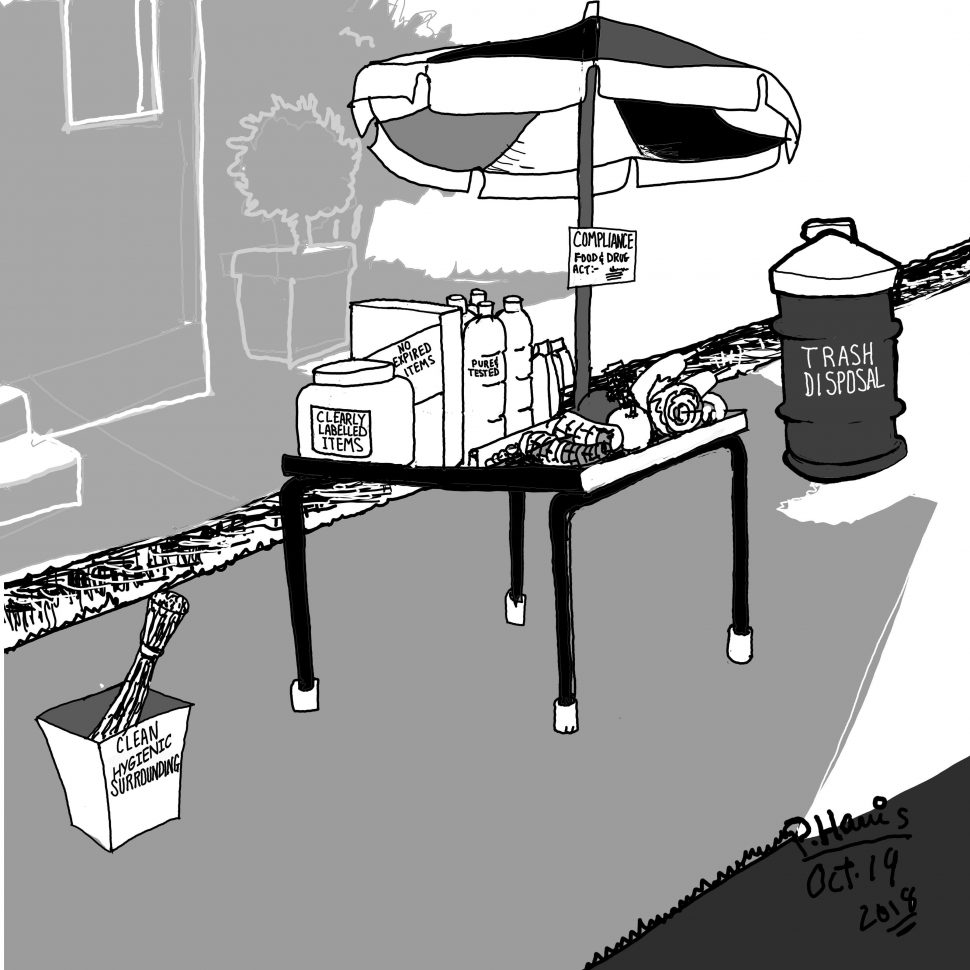With street-vended foods at least equaling restaurant-prepared and home-cooked food in their popularity in Guyana and elsewhere, they have, understandably, become associated with significant health risks arising out of the sheer frequency of their consumption in circumstances where their food-safety ‘credentials’ are, for the most part, unknown.
Working families, including children in their school setting have come to rely increasingly on street-vended foods and the popularity of these offerings extend into the conventional ‘night life’ and ‘hangout’ cultures.
For these reasons the global food industry has paid increasing attention to the safety considerations associated with street-vended foods with issues like storage without refrigeration for protracted periods and the consequential risk of microbial growth, access to clean water for washing produce, hands, or utensils, and appropriate toilet facilities coming into sharper focus.
While on display foods may be inadequately protected from vermin that increase the risks of contamination whilst inexperienced and untrained vendors are more likely than not to have a poor knowledge of basic food hygiene measures, particularly given the fact that there is, invariably, no routine and competent inspection regime to regulate food-vending activities. In the local school system the likelihood of an absence of a built-in education/sensitization programme that specifically addresses the safety considerations associated with the consumption of roadside-vended foods and a corresponding absence of home-instilled sensitization increases the risks associated with the consumption of roadside-vended foods.
Associations between street-vended foods and diarrheal disease have been noted in epidemiological studies particularly in parts of Asia where cholera patients are reportedly eight times more likely to report having bought street foods. Here in Guyana and in other countries where the likely linkage between the consumption of street-vended foods and illnesses often appears to be a lesser official concern, the backlash, invariably, is inexplicable illnesses that are difficult to link to any particular cause.
The potential of street-vended foods to act as vehicles for foodborne illness has been supported by a number of microbiological studies. People with diarrhea or symptoms of gastroenteritis while they are symptomatic should not work in areas where food is handled. Explosive vomiting and diarrhea commonly occur as a result of viral gastroenteritis and can cause a widespread contamination of the immediate environment and directly infect other people. Cross-contamination can also occur when areas are improperly cleaned or sanitized. The question that arises here is whether our local food-vending culture takes serious account of these cause and effect considerations.
The training of food handlers particularly regarding the hazards confronting their products, its safe handling, and the preparation of food following good hygienic practices, as practicable under local street-vending conditions, is an essential part of any strategy to improve the safety and quality of street-vended food. This should, ideally, be performed in conjunction with licensing, but ongoing education and training sessions at intervals are strongly suggested. Unfortunately, there is little persuasive evidence that such training is particularly high on the list of priorities of the municipal and wider state authorities.
Most food-borne hazards may be prevented by thorough cooking, hot holding, rapid cooling, cold storage, avoiding cross-contamination, or a combination of these. However, street-vended foods and their preparation and handling vary enormously and in many instances, do not meet the aforementioned criteria. Consequently, training and education programmes should be based on the food safety hazards presented by the particular local street food or school vending situation. Accordingly, the development of training materials for vendors has to be tailored to meet varying needs and situations.
Frankly, the low level of education among many street food vendors makes across-the-board training difficult and precludes training them in Hazard Analysis and Critical Control Point (HACCP) principles which are not the least complex principles to grasp. Different approaches must be adopted for training street food vendors. Training materials addressing the issues with simple messages must be developed and used to improve the safety of street-vended foods. This information can also be used to inform food safety programme administrators and supervisors about the hazards associated with street food preparation and to influence programme activity priorities.
By identifying the critical practices of specific street food vending operations and by helping to rank operations according to risk, HACCP can be used to target the education and training of those street-vending operations wherein they will be of the greatest benefit in protecting public health. All vendors of high-risk foods and those targeting highly vulnerable customer groups, not least schoolchildren, should be trained in safe food-handling practices, and certification may prove a useful tool to identify those with appropriate training. It also can hardly hurt if some teachers are identified and trained to recognize dangerous situations in food vending at schools and to make interventions.
Arguably, the greatest limitation to such a requirement in countries like Guyana is the inadequate resources of health agencies and their inability to provide the training required for such a large and diverse group as street food vendors. This, however, cannot be tendered as a legitimate excuse for outright indifference.
Reports have shown that an important factor influencing the level of the contamination of food is the knowledge of food hygiene among street food vendors and its correct application by them, in addition to other variables such as their health status and personal hygiene. Street food vendors are often poorly educated, untrained in food safety methods, and are seen to work under unsanitary conditions with little or no infrastructure support. Ironically, research has shown that the majority of food-related illnesses and death could be controlled, or eliminated, by the use of proper food handling techniques. Accordingly, the education and training of street food vendors, including vendors operating on premises or outside of schools, on food hygiene may prove to be the most cost-effective way to reduce the incidence of foodborne diseases.
However, research in this area has been given low attention in developing countries, including Guyana.






